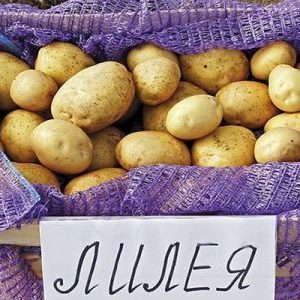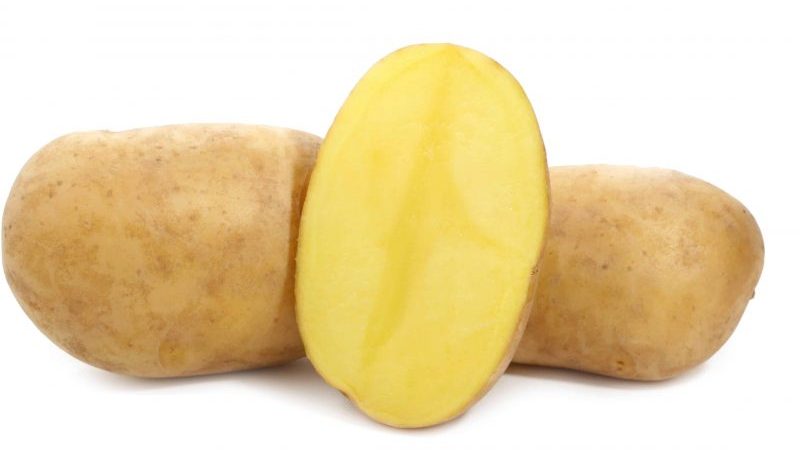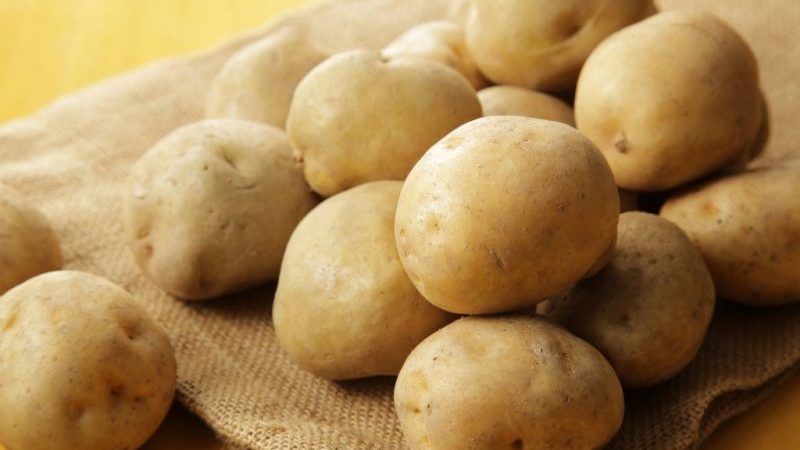A stunning variety of Lileya potatoes with smooth smooth tubers and excellent taste
Potatoes from Belarus are deservedly considered one of the best in the world. A widespread and proven variety of Belarusian potatoes - Lileya. The delicately named potatoes are distinguished by their excellent taste, excellent yield and large size.
Let's talk in detail about its characteristics and the intricacies of growing.
The content of the article
Description of the plant variety
Like any other variety, Lileya has certain distinctive features. Consider the composition, origin and characteristics of the culture.
Origin and development
This is an early table potato variety. Initially it was called Lileya Belorusskaya, but then it spread in four regions of Russia, and in 2008 the official name was reduced to just Lileya. Distributed in the Northern, Northwestern, Central regions of the Russian Federation.
Chemical composition
The composition of this variety is not much different from others. Its peculiarity is the increased content of sterol.
The composition also contains:
- amino acids;
- carotene;
- organic acids;
- starch (about 15% in one root crop).
Lileya is rich in vitamins A and B, so it is perfect for everyone who follows a healthy diet.
Characteristics and appearance
The plant has a typical appearance - a bush of medium height, moderately spreading. The stem itself is straight with a lot of green mass. Leaves are medium, green with a slight wavy edge. Corolla flowers are large enough, light.
Nests form from 8 to 15 tubers, which have an oval or round shape, each weighing about 200 g. Lily tubers are approximately the same, small ones are rare. The skin of the potato is yellow, firm and smooth. The pulp is light yellow, does not darken when sliced or cooking... The eyes are small, few and shallow.
Marketable yield is high - from 250 to 400 kg / ha.
For which regions is it suitable
The variety is cultivated in all regions of the Russian Federation. The crop shows excellent productivity not only in the south, but also, for example, in the Vologda region: with competent agricultural technology, the indicators reach 650 c / ha.
The variety is also suitable for northern regions. It takes root well in the Arkhangelsk and Murmansk regions, although it does not give such indicators as in the southern regions.
What is the difference from other varieties
Lileya differs from other varieties in many ways:
- increased resistance to unfavorable climates;
- larger tubers;
- neat in appearance, without defects;
- undemanding to various types of soil;
- gives a good harvest not only in the first years of cultivation, but also in subsequent years;
- bred specifically for cooking.
These advantages distinguish Lileya from other varieties.
Lilly and Liley
There is a potato variety similar to Lilya in name. Lilly is a mid-early variety that belongs to the table variety. Its yield is also high, but it was bred relatively recently, therefore it has not yet received such wide distribution as Lileya.
Moreover, it differs in external features.Lilly tubers have an oval shape, medium to small size, many eyes. Taste qualities are characterized as average. More common in the northern parts of Russia, resistant to various diseases and frost-resistant.
The main advantages and disadvantages of the variety

The Lileya variety is a generally recognized "favorite". It is no coincidence that he received such wide distribution and is in demand among summer residents.
Experts attribute the following features to the merits:
- high productivity;
- resistance to various weather conditions;
- versatility of tubers;
- good external data;
- high taste and market indicators.
It has practically no drawbacks, with the exception of vulnerability to pests and diseases. However, these disadvantages are inherent in other varieties of potatoes. But with proper care, the risks of infection and pest attacks are reduced to a minimum.
Features of planting and growing varieties
Even a novice gardener can grow this unpretentious variety. However, it is important to know the basic rules of farming and be guided by weather conditions. Let us examine in detail the features of potato cultivation.
Preparing for landing
First, choose the right seed. You will need medium-sized specimens of an even shape without damage and dark spots. It is not necessary to treat tubers with chemical disinfectants, but growth stimulants (for example, "Epin", "Bioglobin" and other safe means) will not interfere.
About a month before planting, potatoes are germinated in a well-lit area. At this point, the tubers are slightly moistened by sprinkling with plain water on both sides. When the shoots are 1.5 cm long, the potatoes can be planted outdoors.
Timing, scheme and landing rules
There is a certain scheme landing, the observance of which guarantees the formation of larger and more numerous tubers.
Potatoes are planted in the ground when the soil is warm enough. It is important to make a measurement: at a depth of 8 cm, the earth should be warmed up to + 10 ° C.
Planting pattern - 60 by 30 cm: do not allow the bushes to grow too close, shading each other. Some gardeners use the 80 cm per row pattern in order to increase the yield.
When planting, the holes should be about 10 cm deep, it is advisable to plant large tubers deeper, small ones closer to the surface. In dense soil, a depth of 5-6 cm is sufficient.
Growing features
With top dressing, the yield of the variety will be 20-40% higher. The best option is a mineral complex that contains the entire set of necessary elements. Sometimes nitrogen fertilizers are used to accelerate the growth of tops. However, an excess of fertilizers will not do good - 2-3 additional dressings are enough for potatoes during the season.
Important. Watch the weather conditions. If the season is rainy, there is no need to water the tops, otherwise the tubers will rot.
The nuances of care
In addition to watering, you need to weed and huddle the beds in a timely manner. They are cultivated three times a season, carefully removing the weeds. It is advisable to mulch with cut grass or even straw. During this period, additional feeding is also recommended, for example, mineral fertilizers based on potassium and magnesium, mixed with bird droppings.
Farmers know there will be less weeds if they periodically loosen the soil using a simple rake or harrow. Loosen diagonally so as not to damage the tubers. This method allows not only to remove excess grass, but also to improve the "respiratory system" of the soil, retaining the required amount of moisture in it.
Watering mode
Excess moisture can lead to inhibition of growth. Watering depends on weather conditions. In a drought, watered 1-2 times a week. When flowers form, the amount of water is increased.
Watering time is either early morning before the bright sun or late evening.
Top dressing
Twice after planting, the plant is fed. The bushes are sprayed with superphosphates, and growth stimulants are also used three times during the growth period.The first time is fertilization during the formation of leaves, the second - during the appearance of buds, the third - when the tubers are formed.
Disease and pest control
Colorado beetles equally harmful to any variety. Insects are harvested by hand, for prevention, plantings are sprayed with tincture of onion peel.
In addition to the Colorado potato beetle, the wireworm attacks the potato. To destroy the pest, insecticides are used, the beds are regularly loosened and hilled.
Among diseases late blight is known, this disease affects potatoes during rainy periods. To avoid illness, the bushes are sprayed with "Fitosporin". If the bushes are already sick, they are sprayed for 10 days with a solution of copper sulfate (10 liters of water and 2 g of sulfate).
Harvesting and storage
To prevent potatoes from spoiling, they must be properly collected and stored, following simple rules.

How and when to collect
You can try the tubers for the first time in July. But this is only a small part, the main collection period is August. Choose a dry day. On the site, make a fence that will create a shadow and at the same time will be ventilated from all sides. There you need to put the dug out potatoes. Sort the potatoes three weeks after harvest.
Storage features
Potatoes are stored in a dry, cool place with a temperature of +2 to + 5 ° C. The best container is a net or box. The keeping quality of the variety is 90% and higher.
What can be the difficulties in growing
Lileya is one of the easiest varieties to grow. But there are also difficulties, mainly associated with improper care.
This variety needs proper and regular watering, protection from pests. The wireworm and the Colorado potato beetle can spoil crops, so don't forget about hilling, preventive spraying and collecting insects.
Tips from experienced gardeners and reviews about the Lileya variety
We will give some advice from farmers with experience in growing a Belarusian variety:
- Lilia loves to be watered. If nature is supportive, then the potato will grow by itself, no additional feed is needed.
- Do foliar twice a month. top dressing... Spray the bushes with a superphosphate solution.
- It is better to use nets instead of bags or boxes for storage.
You can find many different reviews about the Lileya variety.
Tamara, Krasnodar: «I decided to try a new variety for myself, Lileya. She planted it without any problems, in our south it grows well. The taste turned out to be excellent, the potatoes themselves are dense, large. It goes well in soups, in mashed potatoes and for fries. "
Igor, Novosibirsk region: “I have heard many praises about the Belarusian potatoes. It turned out not in vain. Lileya's potatoes are smooth, without rot. It grows well, it is almost not susceptible to diseases and pests, but stable care is needed. On the whole I am satisfied, now I plant only this variety. "
Conclusion
The Lileya variety is a real achievement of the Belarusian selection. It grows successfully in different climatic conditions, is unpretentious and gives a rich harvest. Due to its excellent taste, it is widely used in cooking and food industry.